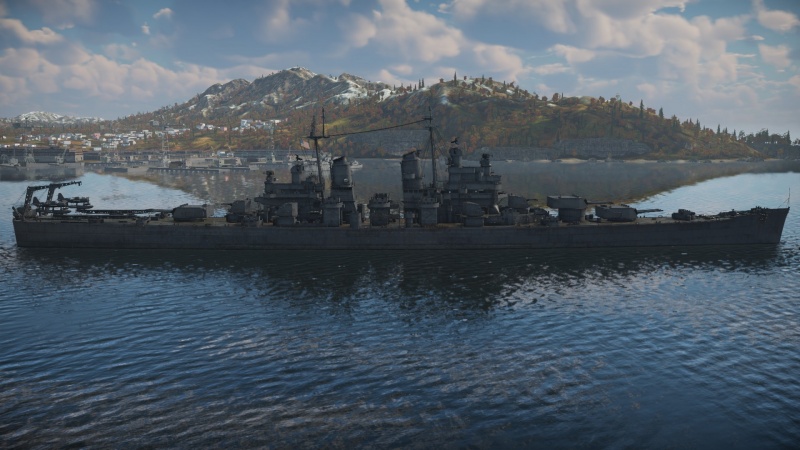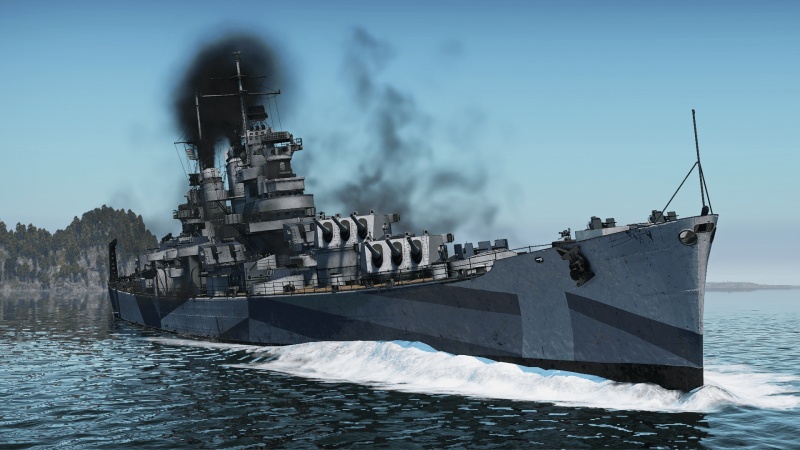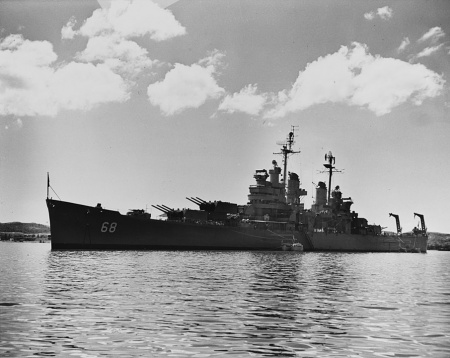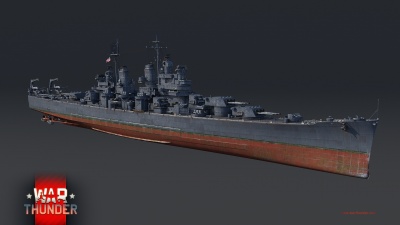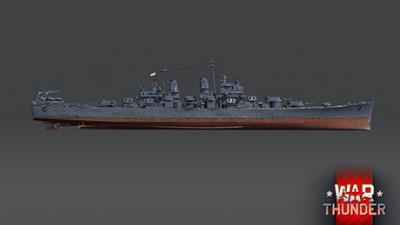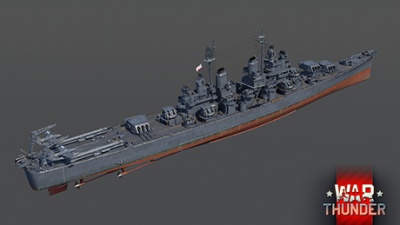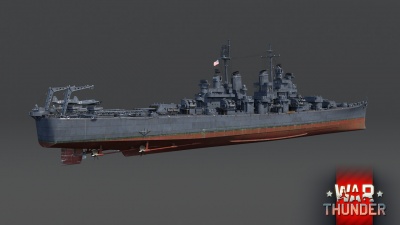USS Baltimore
Contents
Description
The Baltimore-class,USS Baltimore (CA-68), 1943 is a gift rank V American heavy cruiser with a battle rating of 6.0 (AB/RB/SB). It was introduced during Update "Hot Tracks" as a reward for the 2020 Operation W.I.N.T.E.R. event.
The Baltimore-class heavy cruisers represent the zenith of the United States Navy "screening fleet" doctrine during World War II. The ships of this class feature a variety of gun calibres placed all over the ship, with the emphasis on providing anti-air defense to fleet carriers taken to another level.
The USS Baltimore, the lead ship of the class, features the highest amount of anti-air armaments of all cruisers in the game (72 in total). This huge amount of guns (consisting of powerful 40 mm Bofors and 20 mm Oerlikon autocannons) will keep all but the most daring of enemy aircraft at bay. Her anti-ship firepower is also not to be underestimated, as she features nine 8 inch (203 mm) cannons with super-heavy APCBC shells and versatile 127 mm secondary turrets. This makes the Baltimore a force to be reckoned with in top rank naval battles.
General info
Survivability and armour
In terms of overall armour, the Baltimore does not have as much armour as a Hipper-class heavy cruiser, it is somewhat on par with IJN counterparts such as the Mogami.
As with most of the US destroyers and some cruisers, the Baltimore's hull were clad with anti-fragmentation armour to protect her crew from HE shells, with her deck armour have 28.5 mm of thickness, 12.7 mm on her bow and stern, and 19 mm on the central compartments. When angled properly, she can absorb any cruiser-calibre HE shells with little to no crew loss and immune to destroyer-calibre HE shells as long as it didn't damage her wide array of secondary and AA armaments. With each crew compartments and critical modules placed further away from each other, the Baltimore is highly resilent to fire damage.
In terms of armour and module protection, the Baltimore is expectedly well-armoured. Her frontal and rear auxiliary magazine rooms were located below the waterline and were clad with 76 mm of armour at the sides, 63.5 mm at the deck, 140 mm at the bulkhead, and 127 mm at the stern. Her citadel is very well-armoured, with 152 mm at all sides except 63.5 mm at the deck. Her main turrets is protected with 203 mm at the front, 82.5 mm at the sides, 76 mm at the top, and 36.5 mm at the rear, and thus is harder to be taken out.
Baltimore's protection is not without weakness, however. Her fatal weakspots is her main magazine room which were located inside the shell elevator sitting way above the waterline, with an intention of providing Baltimore a consistent firepower without having to restock the ready racks. While the shell elevator is heavily-protected (with 160 mm of armour), a well-aimed AP-shots that manage to get inside the magazine is most likely to detonate it, causing fatal damage.
Having lots of AA also means lots of crew (1,560). However, lots of crew can also be lost due to the AA and secondary turrets being repeatedly destroyed. It is not recommended to repair the ship unless major damage has been sustained.
Mobility
The Baltimore's top speed is on par with that of the Hipper-class heavy cruiser, her agility is better however. She is unlikely to evade a torpedo if spotted too late, but being a heavy cruiser, she should survive a hit or two.
| Mobility Characteristics | |||
|---|---|---|---|
| Game Mode | Upgrade Status | Maximum Speed (km/h) | |
| Forward | Reverse | ||
| AB | |||
| Upgraded | 71 | 29 | |
| RB/SB | |||
| Upgraded | 61 | 25 | |
Modifications and economy
Armament
Primary armament
The Baltimore features 9 x 8 inch/55 Mark 12 (203 mm) cannons in three triple turrets arranged in A-Bs-X setup as her main armament. The guns have a rather mediocre traverse speed, but with a decent amount of firing angle to help increase her survivability when angled.
As with any other American heavy cruisers, the Baltimore's main guns have a mediocre rate of fire per minute than its contemporaries, with 15 seconds (ace crew) of reload time. Thought this is a noticeable improvement compared to other American heavy cruisers armed with a similar-sized guns. The guns is also quite accurate with relatively low dispersions.
As an event ship, the Baltimore comes completely stock. The ship utilizes a "common" type SAP shells as default shell, which is completely inadaquate against most opponents that she will face. While the shell has a sizeable filler of 4.84 kg of TNT equivalent, its penetration of 71 mm at 10 km is terrible (especially for its calibre), and is unable to put a dent on most enemy cruiser beyond 7.5 km range. This means you have to get dangerously close to enemy to deal damage, and thus exposing yourself as a target for enemy ships.
Depending on your preference, you might wanted to get the "super-heavy" APCBC shell first before getting repair kits and FPE. The "super-heavy" shell are the trademark of the Baltimore-class heavy cruisers, since these shells are heavier than others, weighing over 151 kg. Most other nations' shells weight usually around 110 kg. This gives them a longer flight time, but a steeper angle. The idea behind its design was that, at long ranges (~9 km), the shells would penetrate battleship's decks from above instead of hitting the much thicker side armour, potentially reaching critical components. With 256 mm of penetration at 10 km and the aforementioned unique properties, the shell is able to reach further into enemy ship's critical components, and dealing much higher post-penetration damage than its counterparts due to the weight of the shell.
Other than the "super-heavy" APCBC shell, the Baltimore also has an access to a general-purposes HE shell with decent 9.5 kg of TNT equivalent filler to soften enemy ships, and a "special" SAP shells with a marginally better penetration but worse filler, which is still ill-suited against anything beyond 8 km.
Secondary armament
The Baltimore features 12 x 5 inch/38 Mk.12 (127 mm) dual-purpose guns in six double turrets, two at the port and starboard sides each, and one at the front and the rear of her superstructure. These turrets have similar characteristics with the late war American destroyers such as the Somers or the Moffett, but with even more faster reload time (2.8 seconds with ace crew). As she can use up to 8 guns at once (the same as the aforementioned destroyers), the dual-purpose guns a formidable supporting fire against enemy cruisers and destroyers, and providing potent defence against enemy PT boats and aircrafts.
The shell choice of the secondary armaments is the same as the one found on the American destroyers; a basic HE shell which provides good continuous damage, a SAP shell which ironically has better penetration than the main gun's SAP shell and thus more capable at dealing damage, and a HE-VT shell for anti-air purposes.
Anti-aircraft armament
When it comes to anti-air armaments, the Baltimore takes the whole cake. The Baltimore features a staggering 48 x 40 mm Bofors AA cannons in 12 quadruple turrets and 24 x 20 mm Oerlikon single-mounted placed all over the ship. In total, the Baltimore features 72 anti-aircraft guns, the highest amount of AA armaments in the game. Without even taking the dual-purposes 127 mm guns into account, the Baltimore can create a literal "bullet hell" for any aircrafts and PT boats that are either brave or foolish enough to come close to it and quickly dispatch them. In addition, these guns is also very useful for disabling enemy secondary and AA armaments at closer ranges (~4 km) and chip their crew away.
It should be noted, however, that the Baltimore will usually lose several guns (and a considerable amount of crew in the process) during firefight, and that her AA defence capabilities will be significantly reduced before the enemy team decided to spawn as an aircraft.
Usage in battles
With a wide variety of guns on board and great protection, the Baltimore feels right at home when protecting allies from aircraft and surface targets, as well as acting as a vanguard for the team, providing heavy firepower and taking several hits in return.
Without the super-heavy APCBC shells at the start, the Baltimore's 203 mm guns with an awful stock "common" SAP shells will struggle to damage anything beyond 8 km. Your main priorty is to quickly gain an access to the "super-heavy" APCBC rounds, one should target target enemy cruisers and destroyers at closer range (within 7.5 km), or play as the brawler by utilizing both the primary and secondary armaments and get closer to enemy ship to get more chance of a clean shots and more damage.
Once the "super-heavy" APCBC shell and her the damage control kit (repair kit and FPE) is unlocked. The Baltimore's full potential as a universal gun cruiser will be unleashed. Due to the unique properties of the shell as described in the "Primary armament" section, at longer ranges, the shell is capable of penetrating the usually weaker deck armour instead of side armour, punches deep into the ship with its weight, and dealing devastating damage as a result. This allows a keen captain to take out enemy ship's key compartments (engines, drive shaft, ammo racks) and potentially capable of even ammoracking the enemy battleships. Other than this, the HE shell is handy for softening enemy targets or finishing them off, while the "special" SAP shell is not that much better than the "common" SAP shell.
Other than a powerful 203 mm guns, the Baltimore utilizes a rapid-firing 127 mm secondary guns to deal an additional supplementary damage. As the AI gunners were quite inaccurate, you may wanted to handle the gun youself while the main gun is reloading to fire a more precise shots at enemy.
While the anti-air AI gunners can do its job well (especially at longer ranges) due to them spraying a huge clouds of shells at the enemy aircraft, you might wanted to take control of the gun yourself when the enemy manages to slip closer to you or your allies.
Pros and cons
Pros:
- Hull is clad with layers of anti-fragmentation armour, highly resilent to cruiser-calibre HE shells and fire damage
- Very well-armoured, can take a lot of punishments when angled properly
- Decent mobility for a heavy cruiser
- Great armaments
- Accurate main guns with much better fire rate than other American heavy cruisers
- Super-heavy APCBC shells have high penetration and post-penetration damage, capable of dealing considerable damage even against battleships
- Large amounts of fast-firing secondary 127 mm guns providing good supplementary damage at mid-to-close ranges
- 72 anti-air guns provide amazing aerial and close range defences
- Large crew size, with proper handling and damage control, she can stay afloat for the entire match
Cons:
- Very large target, easy to hit at longer ranges without angling and is vulnerable to torpedoes
- Atrocious stock grind, as the default common SAP shell have very poor penetration
- While faster than other American cruisers, the guns still have somewhat slow rate of fire compared to its contemporaries of other nations
- No torpedo armaments, have to rely solely on the guns to deal damage
- While heavily armoured, a well-placed AP shots can detonate her ready shells in the elevator
History
USS Baltimore (CA-68) was the lead ship of her class of heavy cruisers built for the United States during the Second World War. Based on the preceding unique heavy cruiser Wichita, the Baltimores were extremely heavily armed and carried a potent anti-aircraft armament, though like all other American cruisers, they lacked torpedo armament. Baltimore saw extensive service in the Pacific Theatre during the Second World War, and carried Franklin D. Roosevelt to his meeting with American military leaders at Pearl Harbour. After the war, she was reduced to reserve, but reactivated for the Korean War. Despite false allegations by the North Koreans that Baltimore had been sunk by North Korean G-5 torpedo boats, she was actually reduced to reserve, and scrapped by 1973.
Design and development
The Baltimore class was designed to be a successor to the previous Pensacola, Northampton, Portland and New Orleans classes. The ship’s design was based off of the USS Wichita, a unique heavy cruiser built just before the outbreak of hostilities. The hull itself was also extremely similar to the hull of the Cleveland class, a class of light cruiser that was then under construction. Superficially, the Baltimores look extremely similar to the Clevelands, but carried a heavier main armament. Built to this specification, the USS Baltimore was laid down in May of 1941, and commissioned after the start of the war in April of 1943.
Baltimore was 205 metres long and displaced almost 14000 tons standard, making her considerably heavier than her predecessors. Her main armament consisted of nine 8-inch (203 mm) guns in three triple turrets, the same layout as the preceding cruiser classes. However, Baltimore carried a significantly-improved secondary and anti-aircraft armament suite, composed of twelve 5-inch (127 mm) guns in six dual mounts, 48 40 mm Bofors anti-aircraft guns in 12 quad mounts, and 24 Oerlikon anti-aircraft guns in single mounts. Powered by steam turbines delivering 120 000 shaft horsepower, she was capable of making 33 knots (61 km/h).
Operational history
Following her commissioning in 1943, Baltimore joined the Pacific Fleet and spent October-November 1943 in training off the coast of California. Between November 1943 and June of 1944, Baltimore was part of a coastal bombardment force that provided fire support at the Makin Islands, Kwajalein and Truk landings. During this time, the force made great use of Baltimore's heavy main guns, proving themselves to be effective coastal bombardment weapons. Baltimore continued to provide this fire support capacity until June of 1944, when she returned to the Continental United States.
After returning to the United States, Baltimore embarked President Franklin D. Roosevelt and transported him to Pearl Harbour, where the president met with Admiral Chester Nimitz and General Douglas MacArthur. After the meeting, Baltimore transported the President to Alaska, and then returned to active duty. She spent the last part of the war providing fire support for American troops at Iwo Jima and Okinawa. After the cessation of hostilities, Baltimore joined the “magic carpet fleet” and transported American veterans back to their homeland.
After the war ended, Baltimore joined the reserve fleet at Bremerton, where she stayed until the Korean War started. She was reactivated in 1951 and assigned to the Atlantic fleet, meaning that she did not see service in the Korean theatre. She later represented the United States at the UK Fleet Review of 1953, and spent a short time in the Eastern Theatre before being reduced to reserve again. A North Korean museum claims that the Baltimore was sunk by G-5 Torpedo Boats in 1950, and has an exhibit showing “the actual boat” that sank the Baltimore. In fact, the Baltimore was never in the Korean Theatre during the war, and was scrapped in 1973. Baltimore earned a total of 9 war stars for her service during the Second World War.
Devblog
The development of new heavy cruisers for the US Navy began after the outbreak of World War II. The restrictions of the London and Washington Treaties ceased to be relevant, so the United States enthusiastically began to refine the projects built within the limits of the restrictions. Based on the heavy cruisers of the USS Wichita class, a new cruiser was developed to correct the issues of its predecessor, namely low stability and a shortage of anti-aircraft weapons, and also with improved seaworthiness, protection and range. The lead ship of the new series, the heavy cruiser USS Baltimore, was laid down in 1941. The distinctive features of the new large series of cruisers are extremely powerful and versatile anti-aircraft weapons and an increased hull width for increased stability. The USS Baltimore entered service in 1943 and immediately began performing combat missions in the Pacific. Until the end of World War II, Baltimore was in the midst of naval war, taking part in a number of US operations. After a short "vacation" it was re-commissioned in 1951, but did not take part in the new, Korean War. The ship was decommissioned from service in May 1956.
Media
- Skins
- Images
- USS Baltimore (CA-68) Devblog Images
See also
Links to articles on the War Thunder Wiki that you think will be useful for the reader, for example:
- reference to the series of the ship;
- links to approximate analogues of other nations and research trees.
External links
References
- Chen, C. (2005, December). Heavy Cruiser Baltimore (CA-68). Retrieved January 19, 2021, from https://ww2db.com/ship_spec.php?ship_id=165
- Wertheim, E. (2019, September 02). USS Baltimore (CA-68). Retrieved January 19, 2021, from https://www.usni.org/magazines/proceedings/1996/july/uss-baltimore-ca-68
| Bethlehem Steel Corporation | |
|---|---|
| Gun Destroyers (DD) | |
| Porter-class | USS Phelps · USS Moffett |
| Fletcher-class | USS Cowell |
| Destroyer Leaders (DL) | |
| Mitscher-class | USS Wilkinson |
| Cruiser, Light (CL) | |
| Omaha-class | USS Raleigh · USS Detroit |
| Heavy Cruisers (CA) | |
| Northampton-class | USS Northampton |
| Portland-class | USS Portland |
| Baltimore-class | USS Baltimore · USS Pittsburgh |
| Des Moines-class | USS Des Moines |
| USA heavy cruisers | |
|---|---|
| Pensacola-class | USS Pensacola |
| Northampton-class | USS Northampton |
| Portland-class | USS Portland |
| New Orleans-class | USS New Orleans |
| Baltimore-class | USS Baltimore · USS Pittsburgh |
| Des Moines-class | USS Des Moines · USS Newport News |



